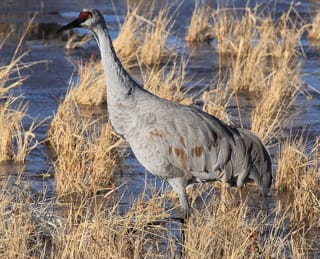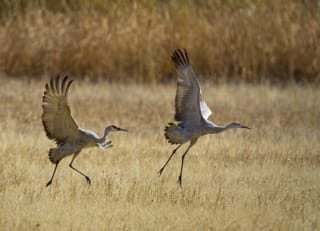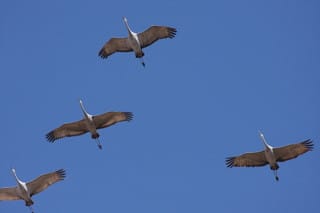Initially this guide displays common birds of all types that are flying right now in our area. Use the selectors below to view rare birds, view birds flying any time, restrict the output to a certain shape of bird, or search by name.
New Mexico is on the western edge of the Central Flyway which is one of the major migration pathways between north and south for birds traveling between breeding and wintering grounds along the Rocky Mountains. This has resulted in the state having an incredible diversity of birds with over 550 different species reported. A little more than half of this number are sighted annually on the Pajarito Plateau. Some of these birds are full-time residents, some migrate here for a few weeks or months, and other are only seen briefly as they pass through the region.
This guide features many of the birds known to frequent Los Alamos county by when they are likely to be seen in the area. You can get additional information on local birds by joining PEEC Birders or going to the eBird website. eBird also includes lists of rare bird sightings and birding hot spots.
Bird References
Birdweb
Cornell Lab of Ornithology
eBird
eNature
Institute for Bird Populations
National Audubon Society
New Mexico Ornithology Society
What Bird
xeno-canto
Subject Area Experts (all guides)
Steve Cary (butterflies)
Beth Cortright (insects)
Terry Foxx (invasive plants)
Leslie Hansen (mammals)
Richard Hansen (fish, mammals)
Dorothy Hoard (butterflies, trees)
Chick Keller (flowers, herbarium)
Shari Kelley (geology)
Kirt Kempter (geology)
Garth Tietjen (reptiles)
David Yeamans (birds)
Web Development and Content Management
Pat Bacha
Jennifer Macke
Graham Mark
Akkana Peck
Contact
Please contact us for local nature questions and sightings. We welcome comments, corrections, and additions to our guides.
For more information about local nature, please visit our Nature Blog or subscribe to PEEC This Week.
Make Selection
 Photo: adult by Josip Loncaric  Photo: adult chasing immature by Mouser Williams  Photo: adults by J.N. Stuart |  Sandhill Crane, Florida CraneSACR (Grus canadensis)Family: Gruidae (Cranes and Rails) Size: 34 - 48 in (86 - 122 cm) Flies: Feb 01 - Apr 07 and Oct 01 - Dec 31 Morphology: slate gray birds with bulky bodies, slender necks, small head, long bills, and short tails with drooping feathers that look like a bustle; adults have pale checks and red skin on the crown; immatures lack the pale check and red crown Status: native; locally common Food source: insects, roots of aquatic plants; rodents, snails, frogs, lizards, snakes, nestling birds, berries, and seeds depending on the location and season Habitat: large freshwater marshes, prairie ponds, marshy tundra Sandhill Cranes can regularly be seen flying far over head during the fall migration. They are abundant at Bosque del Apache in winter where they forage in flocks in the open fields. Courtship for these cranes includes several different “dances”, consisting of leaping in the air with wings spread while calling. There are two versions designed to attract a mate and three others to strengthen and maintain the pair bond. Nests which consist of a mound of plant material are usually located in marshy areas or on the ground near water. Young leave the nest within a day of hatching but are tended by both parents until they are able to feed themselves. First flight is at about 70 days of age. However, the young will remain with their parents for some time, accompanying them during migration. Info Photos Distribution Frequency |
